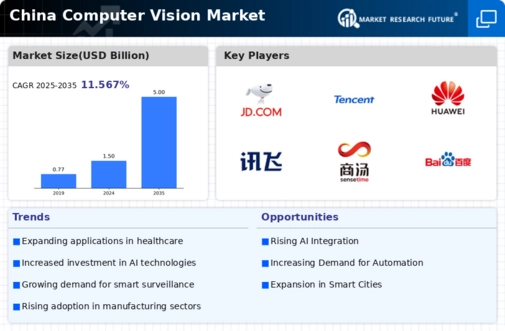Growth in Agricultural Technology
The computer vision market is also experiencing growth within the agricultural sector in China, driven by the increasing adoption of precision farming techniques. Farmers are leveraging computer vision technologies to monitor crop health, optimize resource usage, and enhance yield predictions. This trend is supported by government initiatives aimed at modernizing agriculture and improving food security. Reports indicate that the precision agriculture market in China is projected to reach $12 billion by 2025, with computer vision technologies being a key component of this growth. As the agricultural landscape continues to evolve, the computer vision market is likely to see increased investment and innovation, contributing to more sustainable farming practices.
Emergence of Smart Retail Solutions
The emergence of smart retail solutions is significantly influencing the computer vision market in China. Retailers are increasingly adopting computer vision technologies to enhance customer engagement and streamline operations. These solutions enable features such as automated checkout systems, customer traffic analysis, and personalized promotions based on shopper behavior. The smart retail market in China is anticipated to grow at a CAGR of over 20% through 2026, with computer vision technologies at the forefront of this transformation. As competition intensifies in the retail sector, the integration of smart solutions is likely to drive further adoption of computer vision technologies, thereby expanding the computer vision market.
Rising Demand for Smart Surveillance
The computer vision market in China is experiencing a notable surge in demand for smart surveillance systems. This trend is largely driven by the increasing need for enhanced security measures across urban areas and public spaces. With the Chinese government investing heavily in smart city initiatives, the integration of computer vision technologies into surveillance systems is becoming more prevalent. Reports indicate that the market for video surveillance equipment is projected to reach approximately $10 billion by 2026, with a significant portion attributed to computer vision capabilities. This growth is further fueled by advancements in artificial intelligence and machine learning, which enhance the accuracy and efficiency of surveillance systems. As urbanization continues to rise, the computer vision market is likely to play a crucial role in ensuring public safety and security in China.
Integration of AI in Retail Operations
In the retail sector, the computer vision market is being propelled by the integration of artificial intelligence (AI) into various operational processes. Retailers in China are increasingly utilizing computer vision technologies for inventory management, customer behavior analysis, and personalized marketing strategies. This integration allows for more efficient stock management and enhances the overall shopping experience for consumers. Recent studies suggest that the retail AI market in China could reach $30 billion by 2027, with computer vision playing a pivotal role in this transformation. As retailers strive to adapt to changing consumer preferences and improve operational efficiency, the demand for computer vision solutions is expected to rise, further solidifying its importance in the computer vision market.
Advancements in Manufacturing Automation
The computer vision market is experiencing substantial growth in the manufacturing sector in China, primarily due to advancements in automation technologies. Manufacturers are increasingly adopting computer vision systems to improve quality control, streamline production processes, and reduce operational costs. The integration of these systems allows for real-time monitoring and analysis of production lines, leading to enhanced efficiency and reduced waste. According to industry estimates, the market for industrial automation in China is expected to exceed $200 billion by 2025, with computer vision technologies contributing significantly to this growth. As manufacturers seek to maintain competitiveness in a rapidly evolving market, the adoption of computer vision solutions is likely to become a standard practice, thereby driving further expansion of the computer vision market.





















Leave a Comment